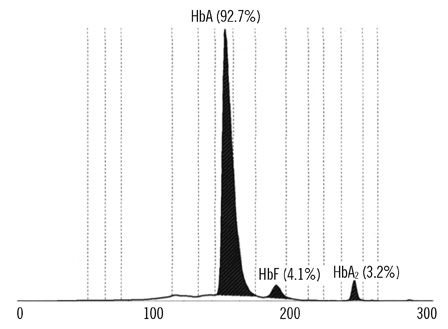Ann Lab Med.
2012 Jan;32(1):99-101. 10.3343/alm.2012.32.1.99.
The First Study on Nucleotide-level Identification of Hb Koriyama in a Patient with Severe Hemolytic Anemia
- Affiliations
-
- 1Department of Laboratory Medicine, Seoul National University Hospital, Seoul, Korea. mwseong@snu.ac.kr
- 2Department of Pediatrics, Ajou University Medical Center, Suwon, Korea.
- KMID: 1781447
- DOI: http://doi.org/10.3343/alm.2012.32.1.99
Abstract
- Hereditary hemolytic anemia comprises a group of disorders in which red blood cells are destroyed faster than they are produced in the bone marrow; various hereditary factors can cause this condition, including production of defective Hb and erythrocyte membrane. Recently, we identified Hb Koriyama, a rare Hb variant that was undetectable in Hb electrophoresis and stability tests, in a patient with severe hemolytic anemia. This is the first study to show the nucleotide-level sequence variations in Hb Koriyama. On the basis of our results, we conclude that unstable Hb may not be detectable by conventional Hb electrophoresis or stability tests. Thus, we suggest further genetic workup in cases of unexplained hereditary hemolytic anemia.
Keyword
MeSH Terms
Figure
Reference
-
1. Natarajan K, Townes TM, et al. Kaushansky K, Lichtman MA, editors. Disorders of hemoglobin structure: sickle cell anemia and related abnormalities. Williams Hematology. 2010. 8th ed. New Yotk: McGraw-Hill.2. Hardison RC, Chui DH, Giardine B, Riemer C, Patrinos GP, Anagnou N, et al. HbVar: a relational database of human hemoglobin variants and thalassemia mutations at the globin gene server. Hum Mutat. 2002. 19:225–233.
Article3. Giardine B, van Baal S, Kaimakis P, Riemer C, Miller W, Samara M, et al. HbVar database of human hemoglobin variants and thalassemia mutations: 2007 update. Hum Mutat. 2007. 28:206.
Article4. Patrinos GP, Giardine B, Riemer C, Miller W, Chui DH, Anagnou NP, et al. Improvements in the HbVar database of human hemoglobin variants and thalassemia mutations for population and sequence variation studies. Nucleic Acids Res. 2004. 32:D537–D541.
Article5. Thein SL. Steinberg MH, Forget BG, editors. Structural variants with a β-thalassemia phenotype. Disorders of hemoglobin: genetics, pathophysiology, and clinical management. 2000. Cambridge: Cambridge University Press;342–355.6. Kawata R, Ohba Y, Yamamoto K, Miyaji T, Makita R, Ohga K, et al. Hyperunstable hemoglobin Koriyama anti-Hb Gun Hill insertion of five residues in the beta chain. Hemoglobin. 1988. 12:311–321.7. Steinberg MH, Forget BG, editors. Disorders of hemoglobin: genetics, pathophysiology, and clinical management. 2009. 2nd ed. Cambridge: Cambridgd University Press.8. Rieder RF, Bradley TB Jr. Hemoglobin Gun Hill: an unstable protein associated with chronic hemolysis. Blood. 1968. 32:355–369.
Article
- Full Text Links
- Actions
-
Cited
- CITED
-
- Close
- Share
- Similar articles
-
- Severe Hemolytic Anemia following Anti-D Immunoglobulin Administration for Acute Immune Thrombocytopenic Purpura in Two-month-old Infants
- A Case of Autoimmune Hemolytic Anemia after Fludarabine Treatment in Waldenstrom Macroglobulinemia
- Thymoma accompanying Autoimmune Hemolytic Anemia
- Two Cases of Autoimmune Hemolytic Anemic
- Cytomegalovirus-Associated Severe Direct Antiglobulin Test Negative Hemolytic Anemia: A Case Report




